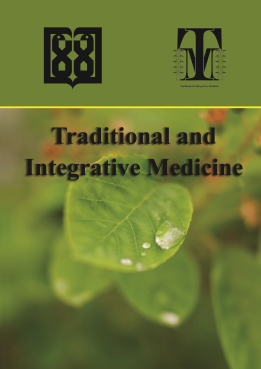2024 CiteScore: 1.4
pISSN: 2476-5104
eISSN: 2476-5112
Chairman:
Hossein Rezaeizadeh, MD, PhD.
Editor-in-Chief:
Roja Rahimi, PharmD, PhD.
Vol 3, No 4, 2018
this manuscript is a letter to editor.
Edible flowers have traditionally been used in various foods and beverages. Besides their usage in culinary arts for flavor and garnish, they are known as nutraceuticals because of having phytochemicals and biological properties. Based on Traditional Persian Medicine, Gulqand is a two-ingredient dosage form containing one type of edible petal mixed with sugar. The most famous Gulqand is prepared with Rosa damascena flowers. In current study, keyword of Gulqand was searched in three medieval Persian manuscripts. Different formulations, preparation method, temperament, effects, multi-ingredient formulations which contain Gulqand, and their applications were extracted. Most of side effects which can be controlled by R. damascena Gulqand was gastrointestinal or relevant to central nervous system like flatus and headache. Golqands, the traditional nutraceutical from sugared petals, are potentials for further research and new products.
Makhzan al-Adviyeh is a medicinal book on simple drugs written with eloquent and fluent prose in Persian by Mohammad Hossein Aghili Khorasani Shirazi in 12th AH century. This book is for sure one of the most comprehensive Persian books on medicinal simple drugs and is very much addressed by traditional medicine researchers. One of the interesting points about this book is the consideration of the scientific names of some of the herbs which are being noted in a Persian book for the first time by Aghili. In this paper, this subject has been addressed together with collecting and describing information regarding the herbs mentioned by their scientific names in the book of Makhzan al-Adviyeh.
Cancer is the second cause of mortality in the world causing poor quality of life. Persian Medicine (PM) is mentioned about cancer in details. Many herbs are claimed to be useful in cancer. This paper aimed to search the most common herbal drugs affecting the cancer based on PM literature. This is a review study based on PM literatures and the electronic databases such as Pub Med and Scopus with the terms like herbal drug and cancer. The study found 15 herbs affecting the cancer. Most of these herbs were investigated in the recent studies. It is recommended further evaluation on plants mentioned in PM books, particularly those with no clinical trials or laboratory tests.
Grief is an unavoidable emotional reaction against the death of beloved ones that can lead to psychiatric disorders. Persian medicine (PM) scholars have made considerable recommendations regarding emotional reactions including grief. This research was carried out by studying outstanding PM textbooks (Canon of Medicine, Zakhireye Kharazmshahi, ExirAzamand kholasa al hekma) with specific keywords related to the emotional reaction, then a series of database queries (PubMed, Scopus and Science Direct) were performed to reconfirm the efficacy of PM recommendations by conventional medicine. PM physicians considered emotional reactions as one of the most important factors in physical or mental dysfunction. They treated bereaved patients based on their mental and cardiovascular conditions. They used a combination of appropriate nutrition, herbal medicines (Amygdalus communis L., Cinnamomum zylanicum, Crocus sativus L., Cydonia oblonga etc.), physical movement (exercise, massage therapy, game etc.) and psychotherapy (music therapy, aromatherapy etc.) for grief resolution. PM is one of the old paradigms of medicine that can improve psychological and physical complications of grief. Grief is one of the debilitative emotions that can influence patient quality of life so it is important and necessary that health authorities and physicians employ the total potential of medical science for patients’ treatment and rehabilitation.
One of the most important problems of women in their reproductive age is menstrual disorders and vaginal bleedings. The prevalence rate of these bleedings among women referring to gynecology clinics has been reported to be 19.1%. Treatment of these disorders in modern medicine includes hormone therapy accompanied with medicinal supplements. Iranian medicine, as a humor-based medicine school, has a specific view about the classification of causing factors of these disorders. This library study was done to investigate the causes of abnormal vaginal bleedings from the perspective of Iranian medicine through reviewing the available texts and references of Iranian traditional medicine. In Iranian medicine books, efrat-e tams (hypermenorrhea) has been classified to two general types of normal and abnormal. In normal type, due to the great amount of blood, the nature decides to exit that from a natural exit such as uterine. The abnormal type is divided into two subtypes; the first, is related to the problems in the quantity or quality of the patient's blood and the second type is due to the problem in the uterine that causes blood loss. It seems that attention to the causes of diseases from the perspective of Iranian medicine opens a new perspective in the treatment of menstrual disorders for modern physicians. Studying these causes, beside whatever is known in modern medicine about control of menstrual disorders, can help us for a better treatment with fewer complications.
Based on numerous written works of Persian scholars of Middle ages, Traditional Persian Medicine (TPM) has its own capabilities and strengths. According to TPM, vaginal drug delivery was prioritized to treat gynecological disorders because of the adjacency of uterine and cervix to vagina. This study was carried out to introduce and extract vaginal multi-component dosage forms, suggested by eight key medicinal manuscripts. Traditional terms of abzan, bakhour, fetileh, forzjeh, jalous, hamoul, hoghneh, and shiaf were sought as keywords. More than 670 vaginal formulations had been found for various gynecological disorders such as abortion, amenorrhea, and cervical stenosis. Vaginal dosage forms were categorized based on three physical conditions including solid (forzjeh, fetileh, hamoul, and shiaf), liquid (abzan, jalous, and hoghneh), and gas or smoke (bakhour). More detailed analysis of each vaginal dosage form based on traditional documents is suggested.
2024 CiteScore: 1.4
pISSN: 2476-5104
eISSN: 2476-5112
Chairman:
Hossein Rezaeizadeh, MD, PhD.
Editor-in-Chief:
Roja Rahimi, PharmD, PhD.



 |
All the work in this journal are licensed under a Creative Commons Attribution-NonCommercial 4.0 International License. |
